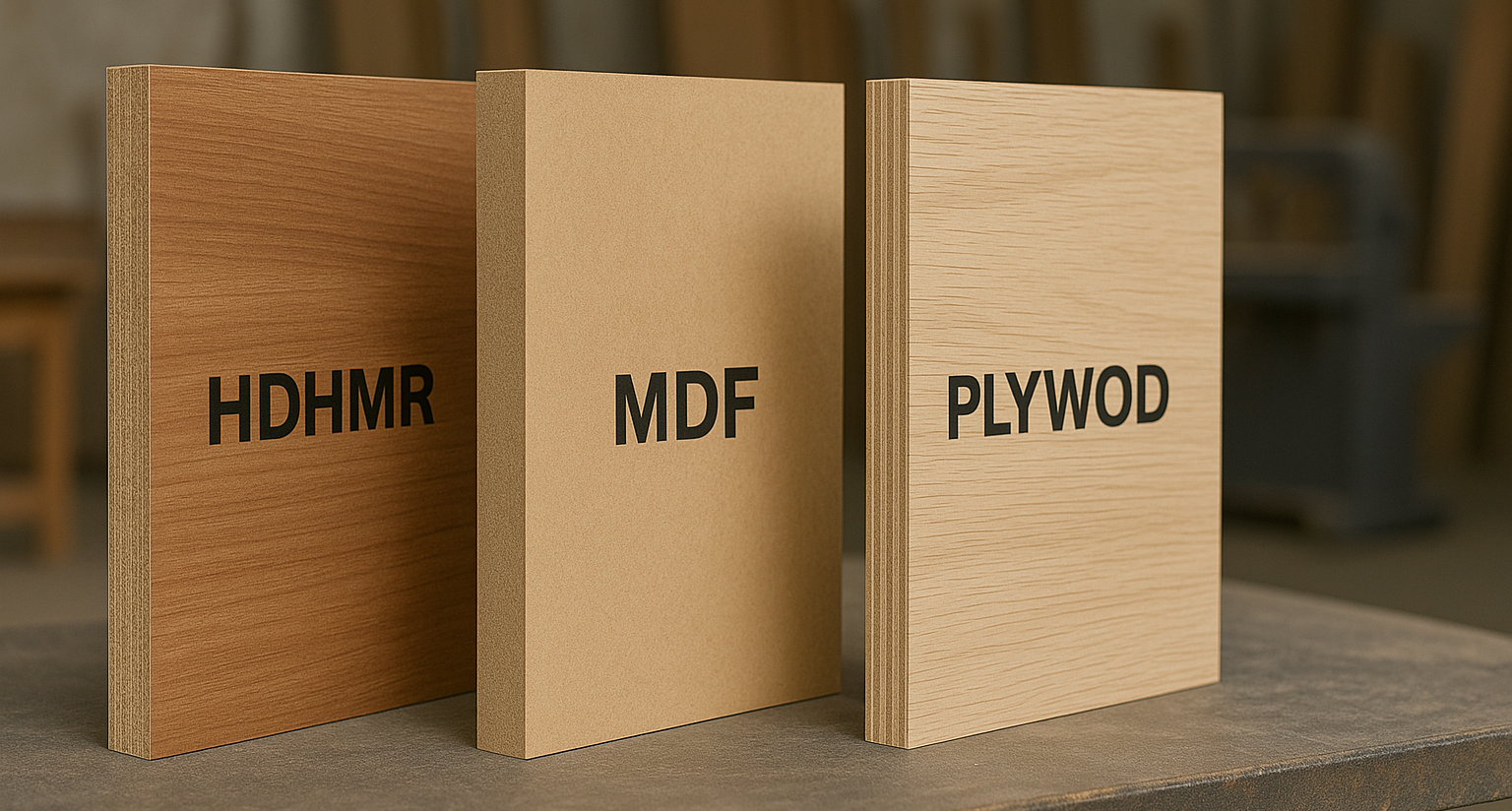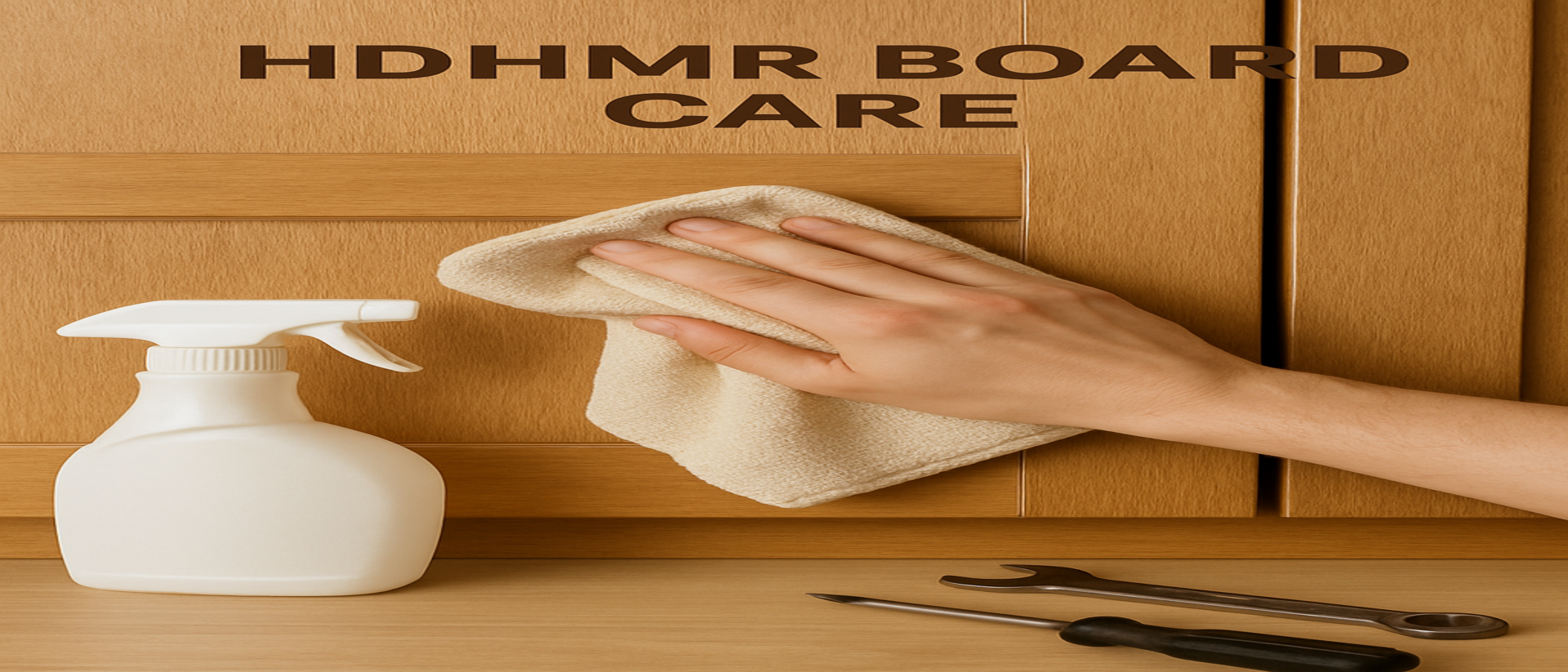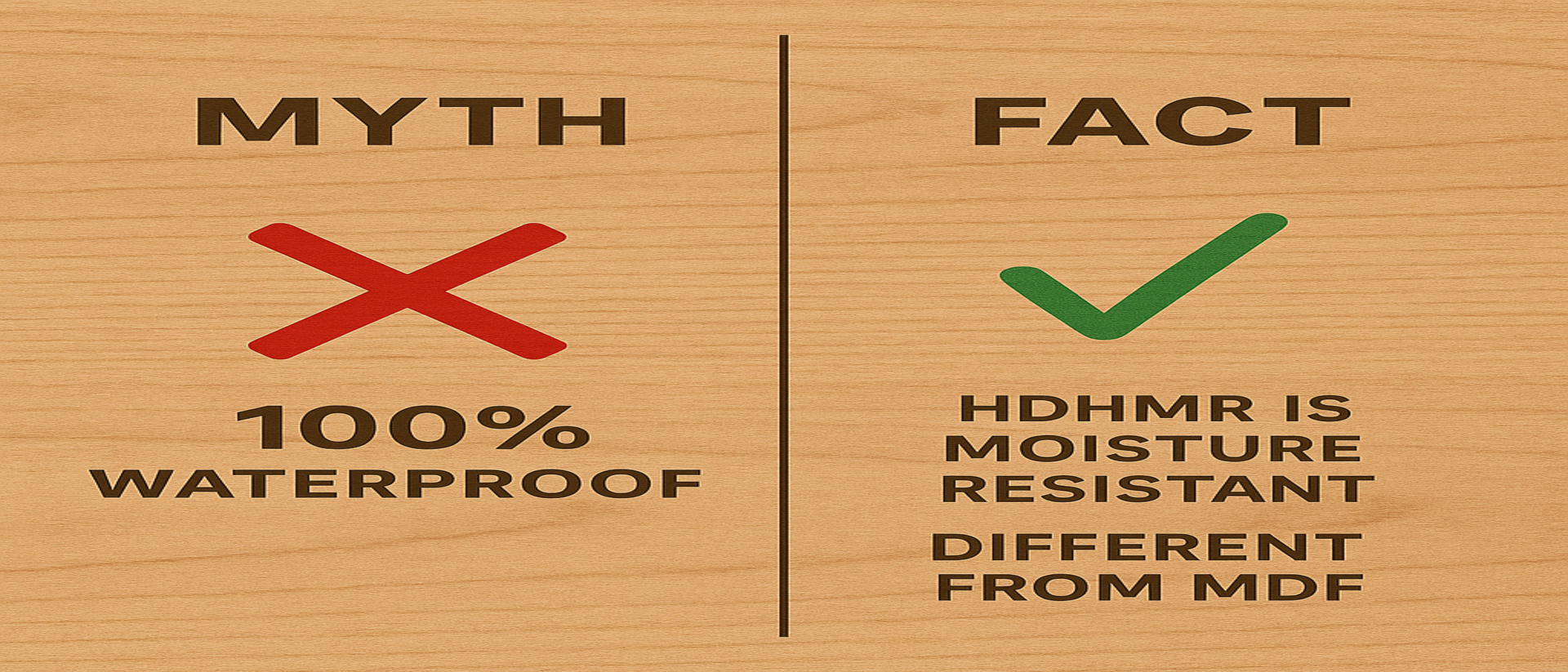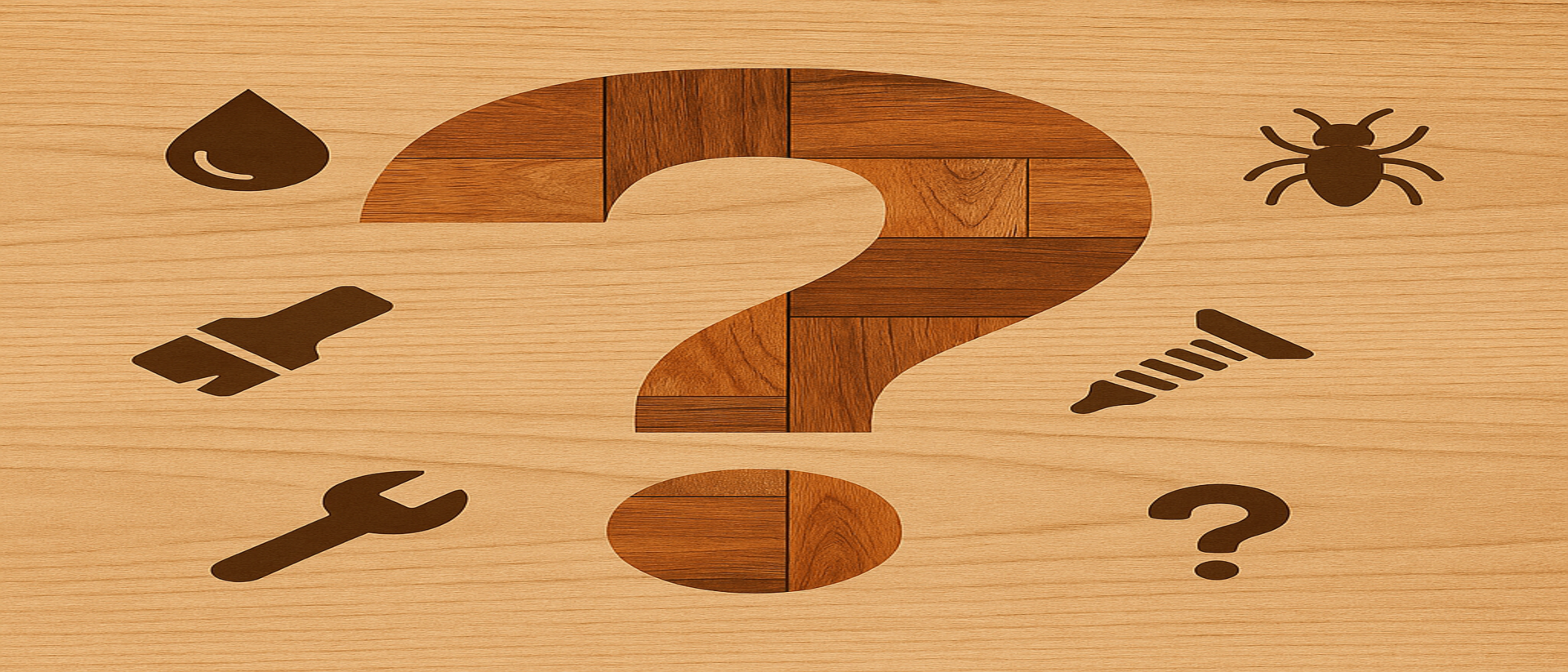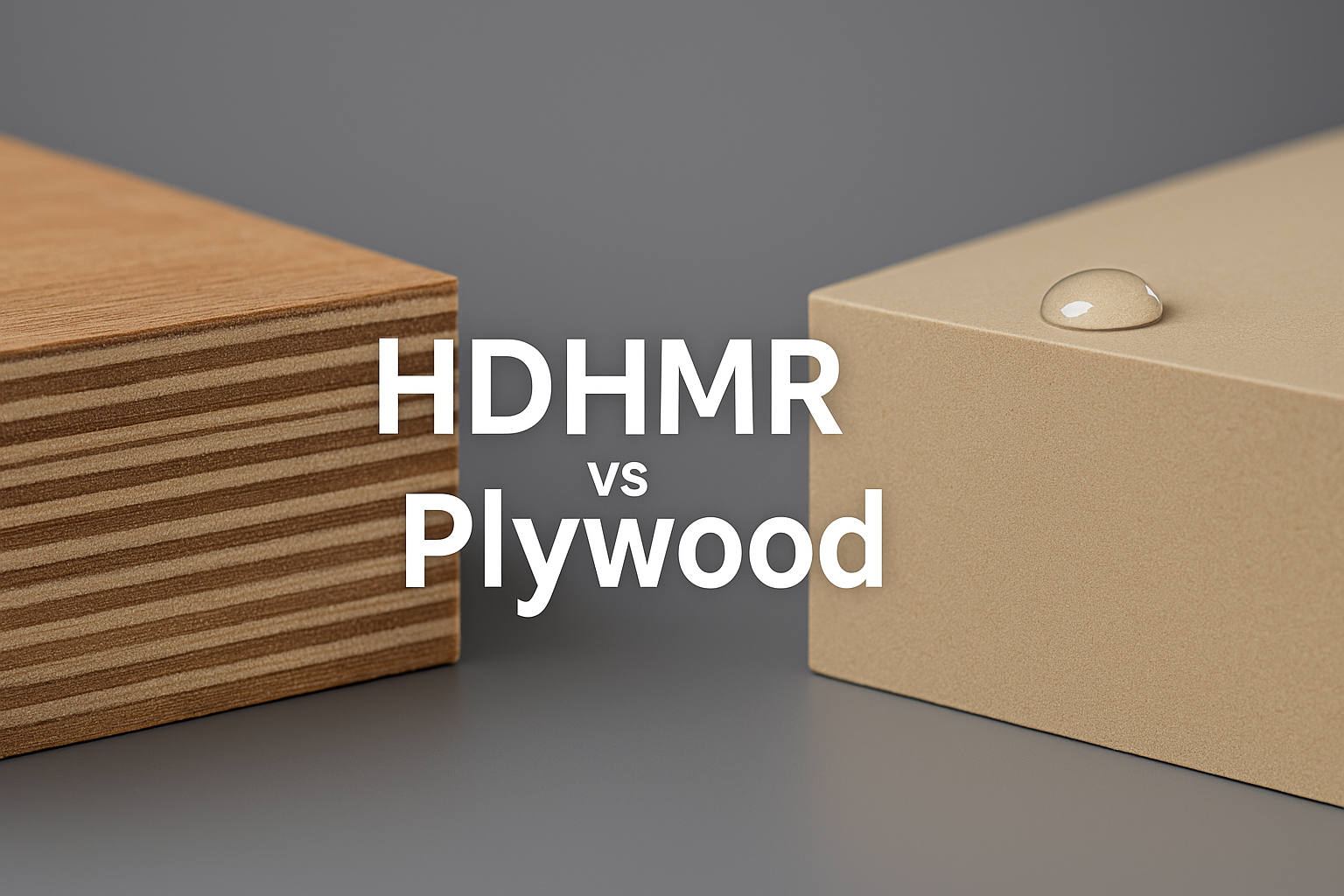Choosing the right wood board for your project can be overwhelming if you’re new to interior materials. HDHMR, MDF, and plywood are three popular options, each with its own strengths. In this guide, we’ll compare HDHMR vs MDF vs plywood in simple terms, looking at how they’re made, how they perform, and where to use each. By understanding the basics of composition, durability, moisture resistance, and cost, you’ll be able to make an informed decision as a beginner.
Composition and Structure
HDHMR (High Density High Moisture Resistant): HDHMR is an engineered fiberboard made by compressing hardwood fibers with moisture-resistant resins under high pressure. Think of it as an advanced form of MDF with extra density and water-resistant glue. As its name suggests, HDHMR is high density – the fibers are packed tightly – and moisture resistant, meaning it’s formulated to resist humidity better than normal boards. The result is a heavy, very smooth board with no layers (it’s homogeneous throughout).
MDF (Medium Density Fiberboard): MDF is also an engineered wood made from wood fibers (often finer than those in particle board) bonded with wax or resin and pressed into sheets. It’s called “medium density” because it’s not as dense as HDHMR/HDF; it has a bit more air content. MDF has a uniform, smooth structure without wood grain, which makes it great for painting. However, standard MDF does not include special water-resistant resins, so it tends to absorb moisture if not sealed, causing swelling or damage. MDF boards are generally lighter than HDHMR and easier to cut, but less sturdy when it comes to holding screws or bearing heavy loads.
Plywood: Plywood is made by layering thin sheets of natural wood veneer and gluing them together with adjacent layers’ grain at right angles. This cross-laminated structure gives plywood strength and dimensional stability. Plywood comes in various grades and types (like MR plywood, BWR, BWP etc.), and its properties depend on the wood species and adhesive used. Typical plywood has a layered structure – you can often see the layers at the edges. Because it’s made of real wood sheets, plywood tends to be lighter than HDHMR (when comparing the same thickness) and has natural grain on the surface. However, unless you buy a waterproof grade (like BWP), most plywood is susceptible to moisture damage and can delaminate or warp if it gets wet.
In summary: HDHMR and MDF are homogeneous fiberboards (no grain, no layers), whereas plywood is laminated layers of wood veneer. HDHMR has the highest density among the three (fibers packed very tightly), MDF is medium density, and plywood’s density can vary by wood type but generally it’s lighter than HDHMR. The high density of HDHMR gives it extra strength and solidity; MDF is slightly softer and less stiff; plywood’s strength can be high, especially along the grain, but it might flex more in certain directions due to the layered nature.
Strength and Durability
When it comes to strength and durability, HDHMR often comes out on top for indoor use. Thanks to its density, HDHMR is extremely sturdy and resists bending or sagging. Shelves or cabinets made from HDHMR can hold heavy items reliably. Additionally, HDHMR’s dense core gives it excellent screw-holding capacity – screws bite into the material firmly, so joints and hinges remain tight over time. HDHMR is also quite tough; it can handle wear and tear, making it suitable for furniture that sees daily use.
MDF has moderate strength. It’s quite stable under normal conditions and doesn’t have weak spots (knots) like natural wood. For lightweight furniture, indoor panelling, or decorative pieces, MDF performs well. However, MDF is not as good as HDHMR at holding screws – because it’s less dense, screws may strip out if over-tightened or if heavy force is applied. MDF furniture needs a bit of care to avoid overloading. Over time, heavily loaded MDF shelves might sag slightly if they’re long and unsupported.
Plywood’s durability depends on its grade and construction. High-quality plywood (like marine grade or BWP plywood) can be very strong and long-lasting, even rivaling HDHMR in load-bearing. Plywood generally has good screw-holding strength as well, especially if you screw into the face (not the edges). One advantage of plywood is a better strength-to-weight ratio – it’s strong without being as heavy as HDHMR. However, lower-grade plywood can have voids or soft spots between layers, and if not treated for termites or moisture, it can deteriorate over time. Warping and cracking are also factors: plywood can warp if it’s not properly seasoned or if it’s subjected to uneven moisture, whereas HDHMR and MDF, being engineered, are more uniform in expansion.
In a straightforward comparison for indoor furniture: HDHMR is the most durable, followed by good-grade plywood, then MDF. MagicBricks’ analysis notes that HDHMR is “highly durable, resistant to warping and cracking,” whereas plywood is durable but “may warp or crack based on quality”. MDF is durable in a climate-controlled, dry environment but would rank below the other two especially if any stress or moisture is involved.
Moisture and Termite Resistance
One of the biggest practical differences comes with moisture resistance and resistance to pests like termites.
- HDHMR: Built to be moisture-resistant, HDHMR boards excel in humid conditions. They do not swell easily when exposed to humidity or occasional water. This makes HDHMR a top choice for kitchens, bathrooms, or sink cabinets where moisture is a concern. Keep in mind, “moisture-resistant” is not the same as fully waterproof – HDHMR can still get damaged by prolonged water contact, but it takes longer and it won’t warp as quickly as plywood or MDF. On the termite front, HDHMR’s manufacturing process inherently helps deter pests. Much of the natural wood content that attracts termites is reduced, and some boards have chemical additives that make them naturally termite and borer resistant. This is a big plus in areas prone to termite infestation; HDHMR cabinets have a better chance of staying unharmed without constant pesticide treatments.
- MDF: Standard MDF is not very moisture-resistant at all. If MDF gets wet, it tends to soak up water, expand, and crumble. Even high humidity can make unlaminated MDF swell over time. There are variants like “HMR MDF” (moisture-resistant MDF) which add green resin for some water resistance, but regular MDF is best kept in dry areas (bookshelves, interior partitions away from water). In terms of termites, MDF has no special resistance. It’s slightly less attractive to termites than solid wood because of the chemicals and lack of grain, but if unprotected, termites can and will chew through MDF eventually. So MDF pieces might need chemical treatment or laminates that prevent access to pests.
- Plywood: Plywood’s moisture resistance depends on its type. Exterior or marine-grade plywood (often labeled BWP – Boiling Water Proof, or BWR – Boiling Water Resistant) uses phenolic resins and hardwood veneers to resist water; these can handle a fair amount of moisture (even boiling water as the name implies) before delaminating or rotting. However, cheaper interior-grade plywood (MR – Moisture Resistant, often mis-called commercial ply) will warp or delaminate if exposed to consistent moisture. Plywood also can develop mold or fungal growth if it stays damp. Regarding termites, unless plywood is chemically treated (some branded plywoods are pre-treated), it is a buffet for termites. Termites can tunnel through the layers of plywood, especially if the core veneers are softwood. You can treat plywood with termite-resistant chemicals or buy plywood advertised as termite-proof, but inherently it’s wood – so it’s vulnerable. HDHMR, by contrast, is often promoted as naturally borer & termite resistant due to its resin content.
Bottom line: For moisture-prone areas, HDHMR is usually safest (besides specialized waterproof plywood). As one design source notes, HDHMR does not warp or break even in very humid conditions, performing better than typical plywood in kitchens or bathrooms. Plywood can work if you pick the right grade (BWP for example), but that can be expensive. MDF should be kept far from water – use it only in dry zones. On termites, HDHMR holds an edge by design; plywood and MDF need added protections to match that.
Ease of Work and Finish
Beginners often wonder which material is easier to cut or shape, and how the finish (paint or laminate) will look:
- HDHMR: Despite its density, HDHMR is relatively easy to work with using power tools. It cuts cleanly because of its uniform fiber structure – you can achieve detailed routing or carving on HDHMR without the material chipping (no splinters or knots). It is, however, heavier than MDF or many plywoods, so handling large HDHMR boards might be a two-person job. Drilling and screwing into HDHMR is smooth, and as mentioned, screws hold tight. Finishing HDHMR is a pleasure: the surface is already smooth, ready for paint or laminate. You won’t have voids or rough patches to deal with. If painting, a primer and paint will give a furniture-grade finish easily. If laminating, the flat surface bonds well with laminates or veneers. In fact, the lack of grain “telegraphing” means you get a very even finish. Many find that HDHMR offers a paint-ready surface straight from the manufacturer.
- MDF: MDF is often lauded for its ease of cutting and milling. It is softer and less dense, so it cuts like butter on saws (which also means blades dull a bit less compared to cutting HDHMR or plywood). MDF is excellent for CNC cutting or creating decorative profiles on edges because it has no grain that could chip out. It does produce a lot of fine dust when cut, so proper masking and dust collection are needed for safety. Finishing MDF also yields great results – it has a smooth surface ideal for painting. One thing to note is that the edges of MDF are more porous; if you cut an MDF board, the face is smooth but the edge might need sanding and maybe a swipe of primer or putty to seal before painting, otherwise it can absorb more paint. MDF can also be laminated or veneered, but it’s typically used in painted applications or with a factory laminate. It does not splinter, which is beginner-friendly.
- Plywood: Plywood can be a bit trickier to cut cleanly because of the layers. When sawing across plywood, you may get splinters or tear-out, especially on the surface veneer. Using sharp blades and cutting tape can mitigate this. Plywood’s layered edges usually need edge banding or veneer strips if you want a smooth look, as the layers are visible (some people actually like the strata look as an aesthetic choice, but in cabinets it’s usually covered). Plywood can be sanded and painted, but the natural grain might show slightly unless you use filler – plus you have to be careful not to sand through the top veneer. For laminates and veneers, plywood provides a decent substrate, but you must ensure the surface veneer is well-adhered and free of voids. Bubbles or hollows in cheaper plywood can cause trouble. Plywood is generally lighter to handle than HDHMR, which can be an advantage during installation.
For a beginner, MDF might feel easiest to shape for intricate designs, but HDHMR is not far behind and gives more strength. Plywood requires understanding grain direction and perhaps a bit more skill to avoid splintering edges.
Cost Considerations
Budget can often decide which material you go for:
- HDHMR: HDHMR boards are typically priced somewhat between MDF and high-grade plywood. Many times, HDHMR comes out more affordable than premium waterproof plywood, which makes it attractive for kitchen contractors looking to save cost but not compromise on quality. The exact price varies by thickness and brand, but for example, an 18mm HDHMR sheet might cost a bit less than an 18mm BWP plywood sheet of similar quality. MagicBricks provides a rough range: thinner HDHMR sheets (like 3mm) could be around ₹500 per sheet, while thick ones (25mm) can go up to ₹4500 per sheet. In general, expect to pay more for HDHMR than for plain MDF, but you might pay less than marine plywood. The long-term value is good because you get durability and moisture resistance without extremely high cost.
- MDF: MDF is usually the cheapest of the three, per sheet, for the same thickness. This is why MDF is commonly used in budget furniture (like ready-to-assemble pieces) and in portions of cabinetry where strength isn’t critical. If cost is your primary concern and the application is low-stress and dry (like a decorative panel or closet shelves that won’t bear too much weight), MDF can be a very economical choice. It provides a smooth finish at a low price. Just remember that if it fails due to moisture or overload, the savings might be short-term.
- Plywood: Plywood has a wide price range. Low-end commercial plywood can be quite cheap, closer to MDF pricing, but its performance will also be low (not very moisture proof, etc.). High-end plywood (BWP marine grade, made from hardwood like gurjan or teak) can actually be more expensive than HDHMR. You also have to factor in that you might waste some due to defects in cheaper plywood, whereas HDHMR/MDF have no internal voids – so there’s an efficiency consideration. If you’re comparing costs for a beginner project: for purely indoor use, you might find you get better value from HDHMR than investing in top-grade plywood, because HDHMR gives you premium features at a moderate cost. Plywood might still be preferred for certain structural uses or where you need very large spans with less weight.
To sum up cost: MDF is least expensive but has limitations, HDHMR is mid-range cost with high performance, and quality plywood is often the most expensive (though cheaper plywood exists, it won’t perform like HDHMR or MDF in many aspects).
Ideal Uses for Each (Beginner Recommendations)
- When to Use HDHMR: If your project is a kitchen cabinet, bathroom vanity, or any furniture that could get damp or needs to last long, HDHMR is a top choice. It’s great for cabinet shutters, wardrobe doors, shelves in humid areas, and even decorative wall paneling that might need to resist moisture. Beginners can use HDHMR to ensure their end product has professional durability. Just be ready to handle its weight and use good tools for cutting. HDHMR is also a smart pick if you want a “premium” feel and longevity without jumping to expensive marine plywood. As one interior design source suggests, HDHMR is now widely used for kitchen shutters, cabinets, and furniture because of its versatility and strength.
- When to Use MDF: MDF is fine for indoor furniture pieces that won’t face heavy loads or moisture. For example, a small bookshelf, a decorative cabinet, wainscoting or wall trims, and indoor panels or partitions are classic MDF applications. It’s also commonly used for wardrobe doors with a routed design (like those ornate routed patterns, which MDF handles easily) – but in such cases, it’s often laminated or painted and used in bedrooms (dry areas). MDF is a good beginner material for practicing cuts and joinery because it’s consistent and cheap. You can also use MDF for painting projects because the finish will come out very smooth (e.g., a painted TV console or kids’ study table). Just avoid any place where water could be an issue (no MDF under the sink, please!). Also, if the furniture needs to hold a lot of weight (like a big library shelf full of heavy books), MDF may not be the best choice – either reinforce it or use HDHMR/ply for those parts.
- When to Use Plywood: Plywood remains a great all-rounder, especially for structural needs or where you need the piece to have some flex without breaking. For instance, in frameworks, backing panels, or large storage units, plywood works well. If you’re building something like a window seat, a long countertop base, or furniture that might occasionally get a bit wet but not soaked, a good BWR plywood could do the job. Plywood is also preferred for wall paneling and ceilings sometimes because it can be nailed and holds shape over larger spans. If you plan to apply a natural wood veneer finish, a plywood base might be suggested by some craftsmen (since it’s “wood on wood” bonding). Beginners might choose plywood for outdoor or semi-outdoor projects like a porch swing or garden bench (with proper waterproofing), where neither MDF nor HDHMR is recommended due to direct weather exposure. Essentially, use plywood if you need a time-tested wood sheet and are willing to select the proper grade for moisture and pests, or if weight is a concern (since HDHMR can be heavy in big pieces).
Quick Comparison Table (Key Differences)
For a quick recap, here’s a simplified comparison of HDHMR, MDF, and Plywood on key factors:
|
Criteria |
HDHMR |
MDF |
Plywood |
|
Composition |
High-density fiberboard with moisture-resistant resin. Homogeneous. |
Medium-density fiberboard with standard resin. Homogeneous. |
Layers of wood veneers glued crosswise. |
|
Strength & Durability |
Very high strength, resists warping. Durable under load. |
Moderate strength, can sag under heavy load. Surface durable if kept dry. |
Varies by grade; good plywood is strong, but can warp if low quality. |
|
Moisture Resistance |
Excellent for interiors (high humidity tolerance). Not fully waterproof, but far better than MDF/normal ply. |
Low (unless specially made MR-MDF). Swells with moisture. |
Depends on type: BWP plywood is water-proof, normal plywood is not and may delaminate. |
|
Termite Resistance |
Naturally termite-resistant (due to resin, density). Extra protection built-in. |
Not resistant; needs chemical treatment or laminates to protect. |
Not inherently resistant; can be treated or bought pre-treated, otherwise vulnerable. |
|
Weight |
Heavy (higher density than plywood). |
Moderate (lighter than HDHMR). |
Light to moderate (varies with wood). Often lighter than HDHMR. |
|
Surface Finish |
Very smooth, no grain. Ready for paint/laminate. |
Smooth, no grain. Paints well; edges need sealing. |
Natural grain on face; may need finishing work. Can be painted or laminated, but grain/knots might show if not perfect. |
|
Cost (relative) |
Mid-range (more than MDF, often less than high-end plywood). Good value for features. |
Low – cheapest option for sheet material. |
Wide range: low for commercial ply, high for marine ply. Good plywood can be priciest. |
|
Ideal Uses |
Kitchen/Bath cabinets, furniture in humid areas, high-load shelves, premium interiors. |
Indoor decor, low-stress furniture, painted units, budget projects in dry areas. |
Versatile: structural elements, framing, general furniture, any use if correct grade (esp. semi-outdoor). |
This comparison should give you a clear starting point. As a beginner, always consider where and how your piece will be used. If you need something that “just works” for most indoor furniture and you want a balance of strength and moisture safety – HDHMR is often the answer for modern interiors. If you’re on a tight budget and building something small or purely decorative, MDF is a friend. And if you need proven robustness or are doing something beyond just indoor cabinetry, plywood still holds its ground (pun intended).
By understanding these differences, you can choose the right material with confidence. For more insights on the advantages of HDHMR specifically, you might want to read 7 Benefits of HDHMR Board You Should Know, which delves deeper into why HDHMR shines in many applications. And if you’re curious about another comparison, check out Why HDHMR is Better than MDF or Particle Board for a focused look at HDHMR’s edge over other engineered woods.
Disclaimer: This article is generated using AI-assisted research and is intended for informational purposes only. While we strive for accuracy, readers are advised to verify all technical, pricing, and brand-specific details with official sources. hdhmr.in is not liable for any decisions made based on this content.
